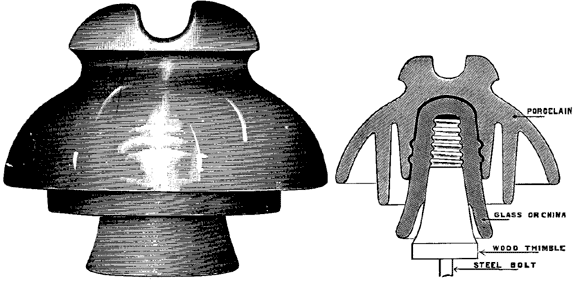[Trade Journal]
Publication: American Electrician
New York, NY, United States
vol. 9, no. 6, p. 245, col. 1-2
THE LOCKE TWO-PART INSULATOR.
In Fig. 1 is shown the Locke two-part insulator, Fig. 2 giving a sectional view of the same. This insulator has been designed to withstand voltages up to 50,000, the construction adopted being such as to resist in a remarkable degree the strain imposed by high voltages.
The insulator is made with an outer shell of china on account of the high surface insulating properties of that material, with which are united great mechanical strength and resistivity to electrical stress. The central portion is of glass, thus combining in one insulator the desirable properties of both glass and porcelain.
 |
| Figs. I and 2.-Two-Part Insulator. |
The insulator is also made of two or more shells of china; the advantage of this over one solid insulator is that the shells being made separately and only 1/2 in. thick, there is greater uniformity of material and more thorough vitrification than could be obtained in a solid body 1 in. thick. In addition, there are four thicknesses of glazing, which further increases the insulating qualities. The manufacturer states that repeated practical tests with 100,000 volts have failed to puncture these insulators, and they are therefore suitable for higher voltages than any yet proposed for commercial purposes.
The body and glaze of these insulators are of simple earths alone, fused together into a vitreous, homogeneous mass under great heat. No lead or other metallic oxide entering, the glaze is not a conductor. The body and glaze being of exactly the same material fired at the same heat, the insulating qualities are uniform throughout.
 |
| Fig. 3.-Oval High-Tension Insulator. |
Fig. 3 shows the Locke insulator used on the Niagara lines. It is oval in form, with eaves or troughs on either side to lead off the water to the remotest edge, the insulator being so fitted to the pole that the drip does not strike the cross-arm or support. The weight of this type of high-voltage insulator is about 12 lbs.
The above described insulators are made by Fred M. Locke, Victor, N. Y.
